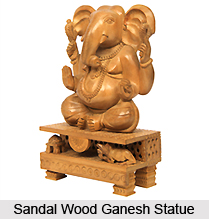 Sandal Wood carving in India is one of the famous and expensive handicrafts. The generic term Bombay boxes include the sandalwood carving of Ahmedabad, Surat and Mumbai. The Surat and Mumbai work is in low relief and the Canara and Mysore work is in high relief, the subjects are mythological. The Ahmedabad work while in flat relief is deeply cut, and the subjects are mixed floral and mythological. Krishna and the Gopies that are represented are treated conventionally. Below the wood a line is drawn through the compartment formed a river that represents flowing.
Sandal Wood carving in India is one of the famous and expensive handicrafts. The generic term Bombay boxes include the sandalwood carving of Ahmedabad, Surat and Mumbai. The Surat and Mumbai work is in low relief and the Canara and Mysore work is in high relief, the subjects are mythological. The Ahmedabad work while in flat relief is deeply cut, and the subjects are mixed floral and mythological. Krishna and the Gopies that are represented are treated conventionally. Below the wood a line is drawn through the compartment formed a river that represents flowing.
The best of Canara carving comes from Compta and the best of Mysore comes from the town of Sorab in the Shimroga district. The most beautiful example of Mysore sandalwood carving was a little cabinet exhibited by Major Puckle in the Annual International Exhibition of 1871. It was surmounted by a triangular headboard. On this Lord Brahma and Goddess Saraswati are carved in the centre. Lord Shiva on Nandi is depicted on one side and Siva and Vishnu combine in Krishna on the other.
On either side of it, an elephant waving a chauri in its trunk; and below it a narrow border is drawn on which were carved Lakshmi, Parvati, Garuda, Hanuman and other Gods in a row. The sandalwood carving of Travancore is naturalistic in style.
Sandal wood is an expensive material for carving artefacts. Sandal wood carvers are found in Bangalore, Mysore, Shimoga, Sorab in the foothills to Sirsi and Honavar and Kumta on the coast. There are two types of Sandal wood: srigandha which is close grained and yellowish-brown and used for carving and nagagandha which is darkish-brown in colour and oil is extracted.
Items such as paper cutters, walking sticks, name cases, trays, boxes, photo frames, fans, cigarette cases, holders and the ever popular elephant are made.
One can find sandal wood art in temples of Kerala. Chests, furniture, collector`s items like paper weights, candle stands, incense stick stands are the items made of sandal wood. Sandalwood artisans follow different patterns like engraved form, sculptural relief and clip. Cochin, Ernakulam, Travancore, Thrissur, Thiruvananthapuram have gained reputation for sandalwood artistry.





















